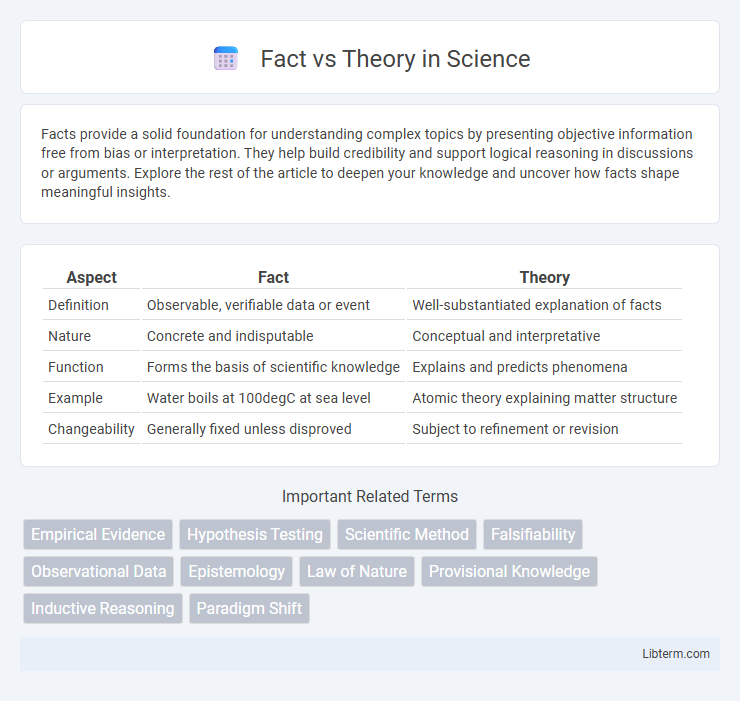Facts provide a solid foundation for understanding complex topics by presenting objective information free from bias or interpretation. They help build credibility and support logical reasoning in discussions or arguments. Explore the rest of the article to deepen your knowledge and uncover how facts shape meaningful insights.
Table of Comparison
| Aspect | Fact | Theory |
|---|---|---|
| Definition | Observable, verifiable data or event | Well-substantiated explanation of facts |
| Nature | Concrete and indisputable | Conceptual and interpretative |
| Function | Forms the basis of scientific knowledge | Explains and predicts phenomena |
| Example | Water boils at 100degC at sea level | Atomic theory explaining matter structure |
| Changeability | Generally fixed unless disproved | Subject to refinement or revision |
Understanding the Basics: What is a Fact?
A fact is an objective reality supported by empirical evidence and observable data, verifiable through measurement or reliable observation. Facts represent concrete information that remains consistent regardless of beliefs or interpretations. Understanding facts is essential for building a foundation of knowledge that informs scientific inquiry and rational decision-making processes.
Defining a Theory: More Than Just a Guess
A theory represents a well-substantiated explanation of natural phenomena supported by extensive evidence and repeated testing, rather than a simple guess or hypothesis. It integrates facts, laws, and tested hypotheses to offer predictive power and coherent understanding within scientific frameworks. Unlike isolated facts, a theory provides a systematic and reliable model that explains underlying mechanisms and guides further research.
Key Differences Between Facts and Theories
Facts are objective observations supported by empirical evidence, representing realities confirmed through consistent measurement or experimentation. Theories are systematic explanations that integrate multiple facts, providing predictive frameworks subject to testing and refinement. While facts describe what is observed, theories explain why phenomena occur, offering broader contexts within scientific understanding.
Examples of Facts in Science and Daily Life
Water boiling at 100degC at standard atmospheric pressure represents a scientific fact observed through repeated experiments. Gravity causing objects to fall toward the Earth is a daily life fact confirmed by consistent observation and measurement. The presence of oxygen in the atmosphere at approximately 21% concentration is another fact essential for understanding biological processes.
How Theories Are Developed and Tested
Theories are developed through systematic observation, experimentation, and the synthesis of multiple facts and hypotheses into coherent explanatory frameworks. They are rigorously tested by generating predictions that can be empirically verified or falsified through controlled experiments and repeated observations. Continuous refinement occurs as new evidence either supports the theory or necessitates its adaptation, ensuring scientific reliability and accuracy.
Common Misconceptions About Facts and Theories
Facts represent objective, verifiable observations or data, whereas theories are well-substantiated explanations that integrate and interpret multiple facts. A common misconception is believing theories are mere guesses or less reliable than facts, whereas theories provide coherent frameworks supported by extensive evidence. Understanding that facts support theories helps clarify that theories evolve with new evidence, enriching scientific knowledge rather than contradicting established facts.
The Role of Evidence in Supporting Facts and Theories
Evidence serves as the foundation for both facts and theories by providing verifiable data obtained through observation and experimentation. Facts represent objective truths supported by consistent evidence, while theories offer comprehensive explanations that integrate multiple facts and are continually tested against new evidence. The strength of a scientific theory depends on the quantity and quality of evidence backing it, allowing it to evolve or be refuted as further empirical data emerges.
Why Theories Are Essential for Scientific Progress
Theories provide comprehensive frameworks that explain and predict phenomena beyond isolated facts, enabling scientists to develop testable hypotheses and guide experimentation. By organizing vast amounts of data into coherent models, theories foster deeper understanding and drive innovation in scientific research. This essential role transforms disparate observations into meaningful insights, accelerating progress across disciplines.
Fact vs Theory in Everyday Language
In everyday language, a fact represents an objective reality supported by verifiable evidence, such as "water boils at 100degC." A theory, however, is a well-substantiated explanation that synthesizes facts to describe underlying principles, like the theory of gravity explaining why objects fall. Understanding this distinction helps clarify discussions by separating concrete data from the interpretations built upon them.
The Importance of Distinguishing Facts from Theories
Distinguishing facts from theories is crucial for scientific progress and critical thinking, as facts represent objective, verifiable observations while theories are comprehensive explanations that interpret those facts. Accurate differentiation ensures clarity in understanding evidence-based knowledge and prevents misconceptions from being accepted as truth. This separation also guides research methodologies, policymaking, and educational frameworks by emphasizing empirical data over speculative ideas.
Fact Infographic

 libterm.com
libterm.com